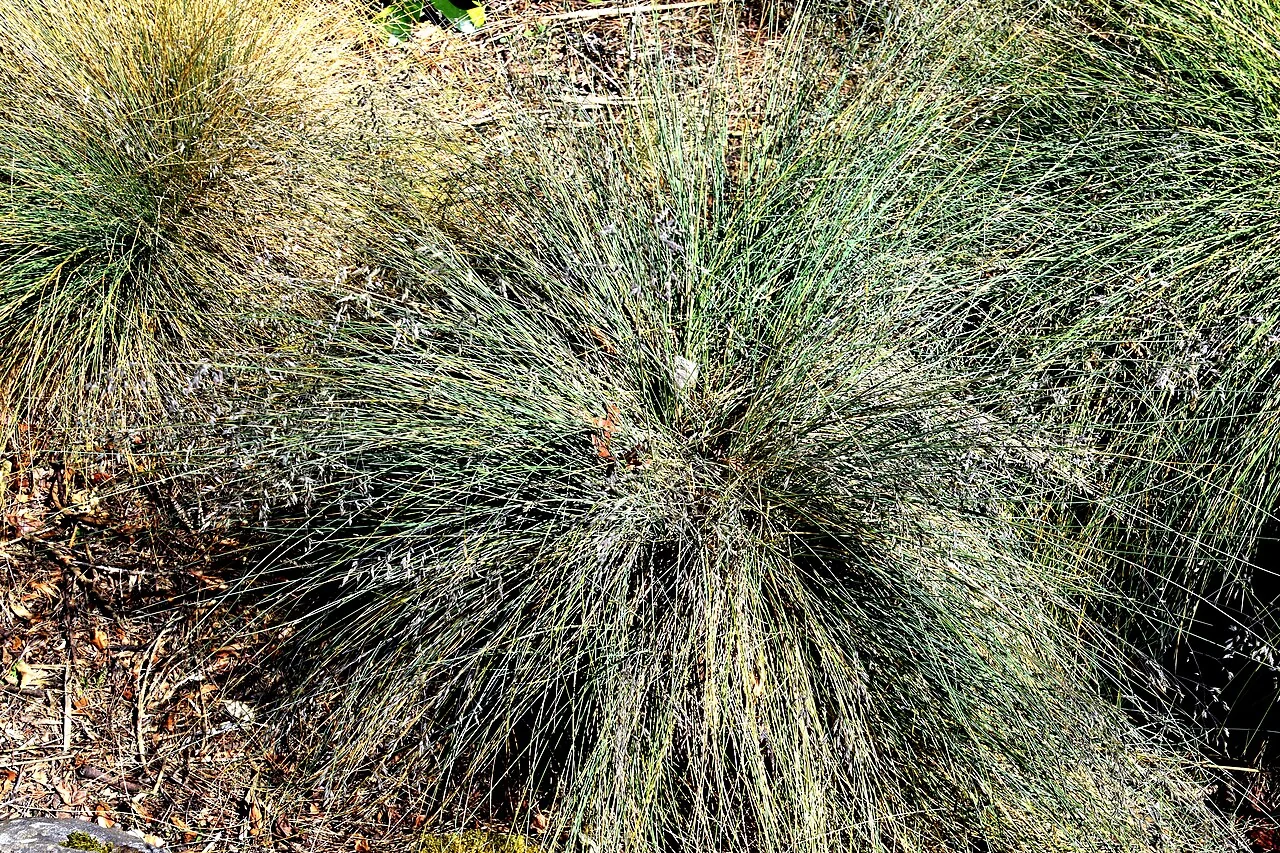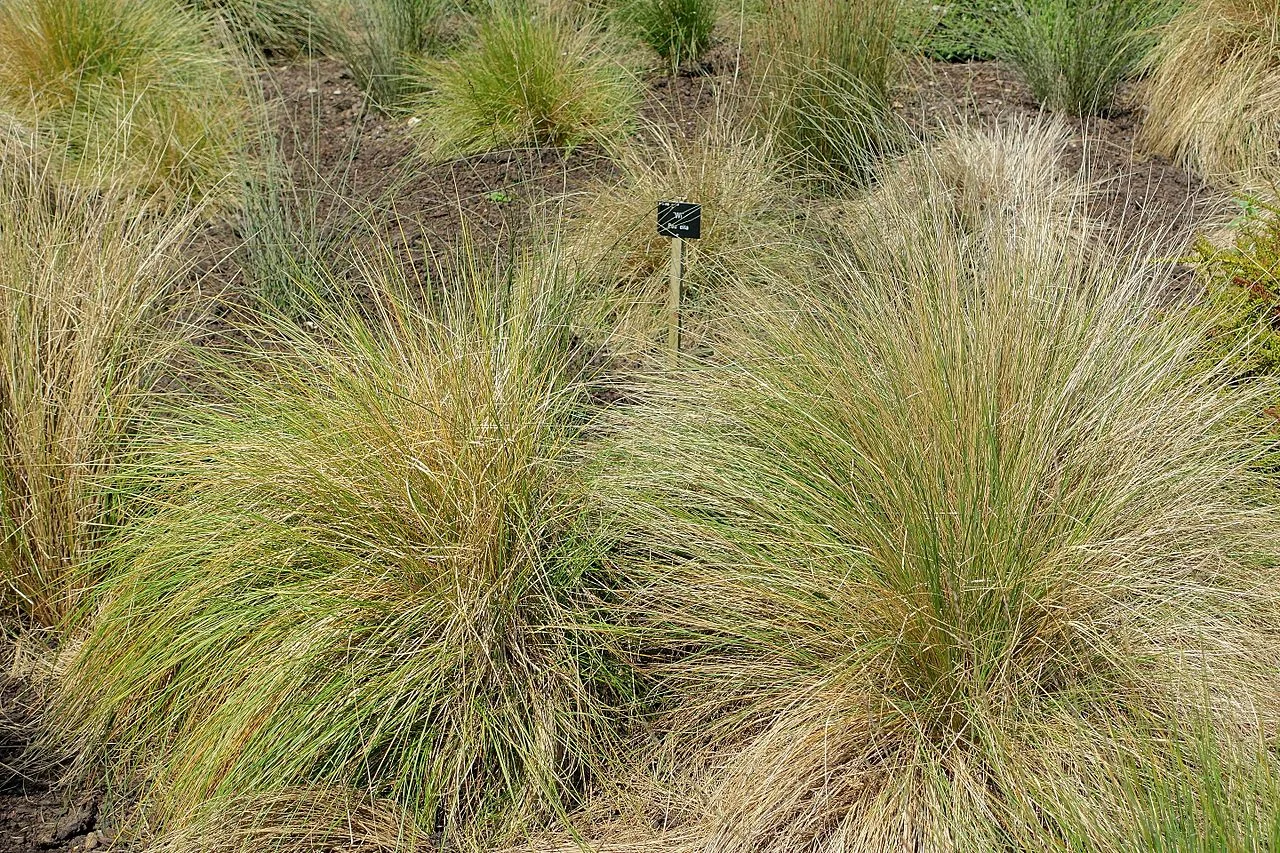
Blue Tussock
Poa colensoi
A compact, often bluish tussock for cool, open sites; neat habit and useful in alpine or gravel gardens. Learn more in our native plants guide .

Plant Description
Botanical Features
Blue Tussock ( Poa colensoi ) is a species of cool-season grass endemic to New Zealand. It forms small, stiff tussocks with tightly-packed shoots, typically growing 5-30 cm tall, but can reach up to 70 cm. The leaves are narrow, rolled, and can range in colour from green to blue-green or blue-grey. This hardy perennial is recognized for its potential in high-altitude livestock grazing systems due to its good palatability and above-average regrowth rates. It produces delicate, arching flower stems with open arrangements of bronze flower heads in spring. It thrives in alpine to subalpine regions and is adaptable to various soil conditions, preferring well-draining soil and tolerating poor to moderately fertile soils.
Quick Facts
Overview
| Scientific Name | Poa Colensoi |
|---|---|
| Height | 0.3-0.8 m |
| Spread | 0.4-0.8 m |
| Light | Full sun |
| Water Needs | Low-moderate |
| Frost | Good |
| Frost Tolerance | Very hardy; excellent frost tolerance |
| Salt Tolerance | Low to moderate |
| Growth Rate | Slow to moderate |
| Lifespan | Perennial |
Climate Best Suited to
Regional climate suitability across major New Zealand cities.
Regional Suitability
| Whangārei | Ideal |
| Auckland | Ideal |
| Hamilton | Suitable |
| Rotorua | Suitable |
| Tauranga | Ideal |
| Gisborne | Ideal |
| New Plymouth | Ideal |
| Whanganui | Ideal |
| Palmerston North | Suitable |
| Napier | Ideal |
| Wellington | Ideal |
| Nelson | Ideal |
| Christchurch | Suitable |
| Dunedin | Suitable |
| Invercargill | Suitable |
| City | Climate Suitability |
|---|
Natural Habitat
Blue Tussock ( Poa colensoi ) is a species of cool-season grass endemic to New Zealand, found on the North, South, and Stewart Islands. It is a prominent component of sub-alpine to alpine tussock-lands and exposed rocky outcrops, showcasing its remarkable adaptation to high-altitude, open environments.
Preferred Conditions:
- Alpine and Subalpine: It thrives in sub-alpine to alpine regions, typically at elevations ranging from 900 to 1,700 meters (3000 to 5,600 ft) above sea level.
- Sunny and Dry: This plant is well-adapted to sunny, dry conditions and is often found in exposed, windy sites. Its resilience to cool-season, temperate to subalpine climates makes it a hardy species.
- Soil: It is adaptable to various soil conditions, preferring well-draining soil and tolerating poor to moderately fertile soils. It is often found on rocky soils.
Distribution:
- Widespread in South Island: While found on all three main islands, it is particularly prominent in Otago and other South Island regions of New Zealand.
- Adaptability: Its ability to adapt to suitable conditions throughout the country highlights its ecological flexibility.
The presence of Poa colensoi in these challenging habitats underscores its ecological importance in contributing to the biodiversity and stability of New Zealand's unique alpine and subalpine ecosystems.
Plant Conservation
Conservation
Poa colensoi , commonly known as blue tussock, is a species of grass endemic to New Zealand. It is a small alpine tussock that typically grows to 30-50 cm in height and width, characterized by its fine, blue-green to blue-grey foliage. According to assessments in 2017 and 2023 by the New Zealand Threat Classification System (NZTCS), Poa colensoi is classified as "Not Threatened" at a national level. This status has been consistent in previous assessments dating back to 2004. Regionally, it is also considered "Regionally Not Threatened" in Otago. Despite its "Not Threatened" status, Poa colensoi faces conservation challenges primarily due to habitat modification, competition from invasive grasses, and changes in land management practices that impact its specialized grassland habitat. Research indicates that disturbances like clipping can significantly reduce Poa colensoi biomass, potentially leading to an increase in invasive species. Conservation efforts are focused on protecting natural grassland habitats, managing invasive species, and maintaining appropriate grazing regimes to preserve the environmental conditions necessary for diverse native tussock grassland communities.
Growing Requirements
Soil
Well-drained, moderately fertile soils; avoid prolonged waterlogging.
Light
Performs in full sun to partial shade depending on species.
Water
Keep evenly moist while establishing; reduce irrigation as roots develop.
Temperature
Hardy in most regions of Aotearoa once established.
For Blue Tussock ( Poa colensoi ), choose a site with full sun and soil that is well-drained, moisture-retentive. Incorporate composted organic matter to improve structure and drainage. Plant with the crown or root collar at soil level, then apply a 5-8â¯cm mulch to moderate temperature, conserve moisture, and suppress weeds. Protect young plants from extremes while establishing and consider the stated frost tolerance (seasonal) when siting near exposure or cold air drains.
Planting Guide
Best Planting Practices
Site in full sun with free-draining, lean soil. Plant slightly high and backfill with a gritty mix to keep the crown dry. Water to establish, then sparingly.
- Soil: Gravelly/sandy, low fertility; avoid heavy clay.
- Spacing: 40-60 cm for drifts; 30 cm for dense edging.
- Mulch: Inorganic gravel mulch preserves the silver-blue look and sheds water.
Ecosystem Notes
- Soil binding: Roots stabilise thin, stony soils.
- Cold tolerance: Suited to frosty, exposed conditions with winter drainage.
- Associates: Alpine hebes, Celmisia , and small Raoulia .
Uses and Significance
Garden and Restoration
A compact, often bluish tussock for cool, open sites; neat habit and useful in alpine or gravel gardens.
- Alpine and gravel gardens
- Mass planting
Sow fresh seed of Blue Tussock thinly on a gritty, free-draining mix and keep evenly moist until germination. Prick out into small cells early to develop sturdy root systems and avoid check.
Cultural Significance
Cultural Importance
Alpine Grasslands
Blue tussock defines subalpine herbfield character; used widely in restoration and interpretation gardens to represent New Zealand's montane grassland heritage and to stabilise thin, stony soils.
While Poa colensoi , also known as blue tussock, is recognized for its ecological importance in New Zealand's tussock grasslands, specific details regarding its direct cultural significance, particularly in Māori traditions, are not extensively documented. However, the broader "tussock grassland heritage" of New Zealand, of which Poa colensoi is a part, holds significance. These grasslands were historically used as occasional fodder for introduced livestock, and while some tussock species like snow grass and red tussock were not ideal for fodder, they were valued for providing shelter and protecting the soil from erosion due to their root systems. The plant's name, colensoi , honors William Colenso, a missionary, printer, botanist, explorer, and politician in New Zealand.
Landscaping Ideas
- Alpine drifts: Mass for silver-blue sweeps that move in wind.
- Rock gardens: Tuck into gravel screes and raised planters.
- Edging: Low ribbons along paths with gravel mulch.
Seasonal Care Calendar
Spring
- Plant and mulch
- Protect new growth from weeds
Summer
- Deep watering in drought
- Monitor pests
Autumn
- Light formative pruning
- Top up mulch
Winter
- Plant eco-sourced stock
- Stake in windy sites
Pruning and Maintenance
Techniques and Timing
Generally minimal; formative work when young and removal of damaged wood.
Prune Blue Tussock lightly to maintain structure; remove damaged shoots and avoid hard cuts on older wood.
How to Grow Blue Tussock
Blue Tussock ( Poa colensoi ) is a hardy, fine-textured New Zealand tussock grass, highly valued for its ornamental appeal and its ability to thrive in challenging alpine and subalpine environments. This compact, often bluish-green tussock forms dense clumps, making it an excellent choice for rock gardens, alpine plantings, or as a low-maintenance groundcover in cool, free-draining sites. Its resilience to frost, wind, and drought once established makes it a popular choice for both ecological restoration and contemporary landscape design. Understanding its propagation methods is key to successfully cultivating this beautiful native grass.
From Seed
Propagating Blue Tussock from seed is a straightforward and reliable method. Collect mature seeds in late summer or early autumn. Sow cleaned seeds in late winter to spring, or in autumn in milder districts. Use a free-draining seed-raising mix, such as a blend of sand and fine pumice or perlite. Sow the seeds thinly on the surface and cover very lightly with a fine layer of medium. Keep the seed tray evenly moist (but not waterlogged) and provide bright, indirect light at cool to mild temperatures (ideally 10-18 °C). Germination is typically quick and consistent under suitable conditions. Once seedlings have developed their first true leaves, carefully prick them out into individual cell trays or small pots. Grow them on in a sheltered environment with good light and steady moisture, gradually hardening them off before planting out into their final positions.
By Division
Division of established clumps is an excellent method for propagating Blue Tussock, especially for maintaining the genetic characteristics of a particularly attractive specimen or for rejuvenating older plants. This is best undertaken in early spring or autumn when the soil moisture is reliable and temperatures are moderate. Carefully lift the entire plant clump using a spade or fork. Gently separate the clump into smaller sections, ensuring that each division has several healthy growing points (tillers) and a good network of roots. Replant the divisions immediately at the same depth as the original plant into prepared soil that is free-draining. Water thoroughly after replanting to settle the soil around the roots and keep the divisions evenly moist until new growth indicates successful establishment. This method is particularly effective for expanding existing plantings or for creating new plants with minimal effort.
Pests and Diseases
Common Problems and Solutions
- Crown rot: Avoid wet, rich soils; prioritise drainage.
- Rust: Improve airflow; remove thatch in late winter.
- Grass grubs: Encourage predators; avoid overwatering.
Bonus Tip
Instead of cutting back hard, gently tease out dead leaves at the end of winter to keep the clump compact and the crown healthy.







